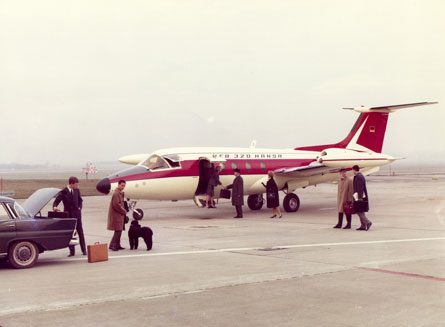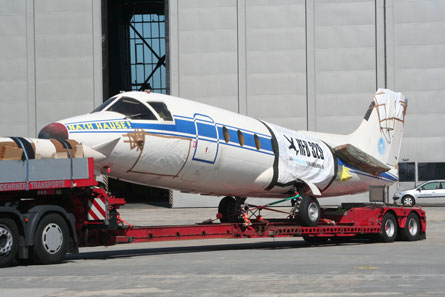In a corner of Airbus's aircraft delivery hall 104 in Hamburg, a private club comprising largely employees of the airframer and nearby Lufthansa Technik is restoring an aircraft which played a significant, but widely forgotten, role in the history of the Finkenwerder site.
In the early 1960s, after some first post-war experience with the under-license production of the Nord 2501 "Noratlas" military transport and becoming a main partner in the Franco-German C160 Transall programme, then-named Hamburger Flugzeugbau (lit. Hamburg aircraft building company, HFB) started cutting metal for its first own - and only - type since Germany's new beginning in 1949.
The HFB 320 Hansa Jet was a business aircraft for up to 12 passengers, which competed directly with Gates' Learjet. Unlike its American rival, however, the General Electric CJ610-powered twinjet had an almost uniquely conspicuous feature: forward-swept wings.
 |
|---|
Chief engineer Hans Wocke had already worked on the unusual configuration when he was involved in the projected Junkers 287 jet bomber during the 1930s, which also had a negative wing sweep. Good slow-flight characteristics were apparently a scoring area because the airflow started to separate at the rearmost part of the wing, close to the fuselage, while the ailerons on the outer section remained undisturbed. The main advantage for the HFB 320 was, however, that the aircraft could have an aerodynamically beneficial mid-wing layout, with the central wing construction placed aft of the cabin, thus leaving standing height for the passengers inside.

The prototype (D-CHFB) took for its first flight on 21 April 1964, and type certification was granted in 1967. However, only 47 Hansa Jets were built until 1973. The production was stopped short of the planned break-even point of 50 aircraft to avoid repaying development funding to the city of Hamburg, because it had become clear that the type was not going to sell in great numbers to make the programme profitable.
LUFTWAFFE'S LIEBLING
Apart from a range of operators across Europe and North America, the German air force became the largest customer, which used it as VIP transport, target-towing and electronic counter measure (ECM) aircraft.
The Luftwaffe also owned the aircraft now under restoration (WN1025). It took off for the first time in December 1966 and was later commissioned by the Bundeswehr's aircraft testing facility, Wehrtechnische Dienststelle (WTD) 61, in Manching near Munich, where it completed its last flight in September 1987, with approximately 2000 flying hours in the log.
Despite its long retirement, the aircraft appears to be a surprisingly good condition. "The director of WTD 61's training facility had a personal interest in the type and kept it in good nick," says Wolfgang Borgmann, chairman of the "Ein Hansa Jet für Hamburg" restoration club. The aircraft was moved into a hangar during winters, it was regularly inspected and hydraulic fluid was topped up.
"Except for some light rust on a number of rivets, we have not found any visible corrosion in any of the cavities we looked into," says Borgmann. The wings and horizontal stabiliser were removed when the twinjet was transported to Hamburg on two low-bed lorries in 2008.
The main structural components will soon undergo non-destructive testing (NDT) before the aircraft can be re-assembled. Provided that no significant damage is found, a regular 2,400 flight hour check should be enough to clear the Hansa Jet as a historic aircraft under German national category 2 regulations for non-commercial flights.
Registering the aircraft under EASA category 1 rule to be able to carry revenue-paying passengers on pleasure flights would lead to a more comprehensive overhaul, which the club could not afford, says Borgmann. However, the planned operation should allow club members to fly onboard on a cost-sharing basis.
ENGINE SURGE
The cockpit will require some updating, such as the installation of modern radio and GPS navigation equipment, but further effort will be needed to get the aircraft moving again. The original engines had already been removed, before the charity bought the aircraft, to power another historic Luftwaffe jet - the replica Messerschmidtt 262.
A private supporter donated two CJ610 engines, but no documents are available for the turbojets, reports Borgmann. He is confident that the club could either get them overhauled and re-certified or find replacement engines on the open market as there is a small active Learjet 23 fleet, which also employed the CJ610.
However, there is still "a bit of time" until the two 13.15kN (2,950lb) powerplants need to be installed, says Borgmann. Given that the club is funded entirely by private donations - Airbus provides the hangar area and its Finkenwerder airfield as a later home base - he declines to specify when the unusual shape will be seen again in the air.
Flightglobal's PDF Archive:
Hansa at Gatwick
Source: Flight International



















